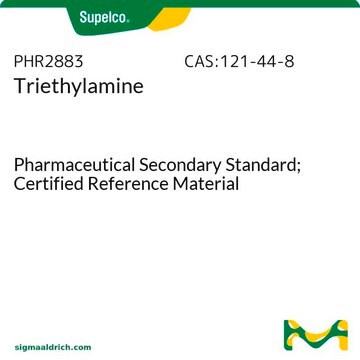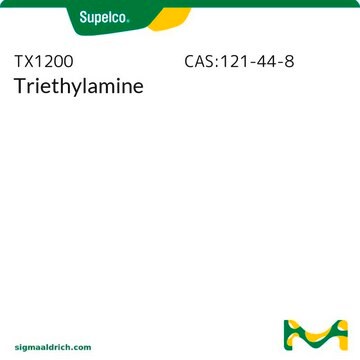73487
Triethylamine
analytical standard
Sinónimos:
N,N-Diethylethanamine
About This Item
Productos recomendados
grade
analytical standard
Quality Level
vapor density
3.5 (vs air)
vapor pressure
51.75 mmHg ( 20 °C)
assay
≥99.5% (GC)
autoignition temp.
593 °F
shelf life
limited shelf life, expiry date on the label
expl. lim.
8 %
technique(s)
HPLC: suitable
gas chromatography (GC): suitable
impurities
≤0.5% water
refractive index
n20/D 1.400-1.402
n20/D 1.401 (lit.)
bp
88.8 °C (lit.)
mp
−115 °C (lit.)
density
0.726 g/mL at 25 °C (lit.)
application(s)
cleaning products
cosmetics
flavors and fragrances
food and beverages
personal care
format
neat
SMILES string
CCN(CC)CC
InChI
1S/C6H15N/c1-4-7(5-2)6-3/h4-6H2,1-3H3
InChI key
ZMANZCXQSJIPKH-UHFFFAOYSA-N
¿Está buscando productos similares? Visita Guía de comparación de productos
Categorías relacionadas
General description
Application
- Food and beverages using ion-exchange chromatography with conductivity detection.
- Smoke flavoring from rice husk using gas chromatography coupled to mass spectrometric detection, flame ionization detection and olfactometry analysis (GC-O).
signalword
Danger
Hazard Classifications
Acute Tox. 3 Dermal - Acute Tox. 3 Inhalation - Acute Tox. 4 Oral - Eye Dam. 1 - Flam. Liq. 2 - Skin Corr. 1A - STOT SE 3
target_organs
Respiratory system
Storage Class
3 - Flammable liquids
wgk_germany
WGK 1
flash_point_f
12.2 °F - closed cup
flash_point_c
-11 °C - closed cup
Elija entre una de las versiones más recientes:
¿Ya tiene este producto?
Encuentre la documentación para los productos que ha comprado recientemente en la Biblioteca de documentos.
Los clientes también vieron
Nuestro equipo de científicos tiene experiencia en todas las áreas de investigación: Ciencias de la vida, Ciencia de los materiales, Síntesis química, Cromatografía, Analítica y muchas otras.
Póngase en contacto con el Servicio técnico











